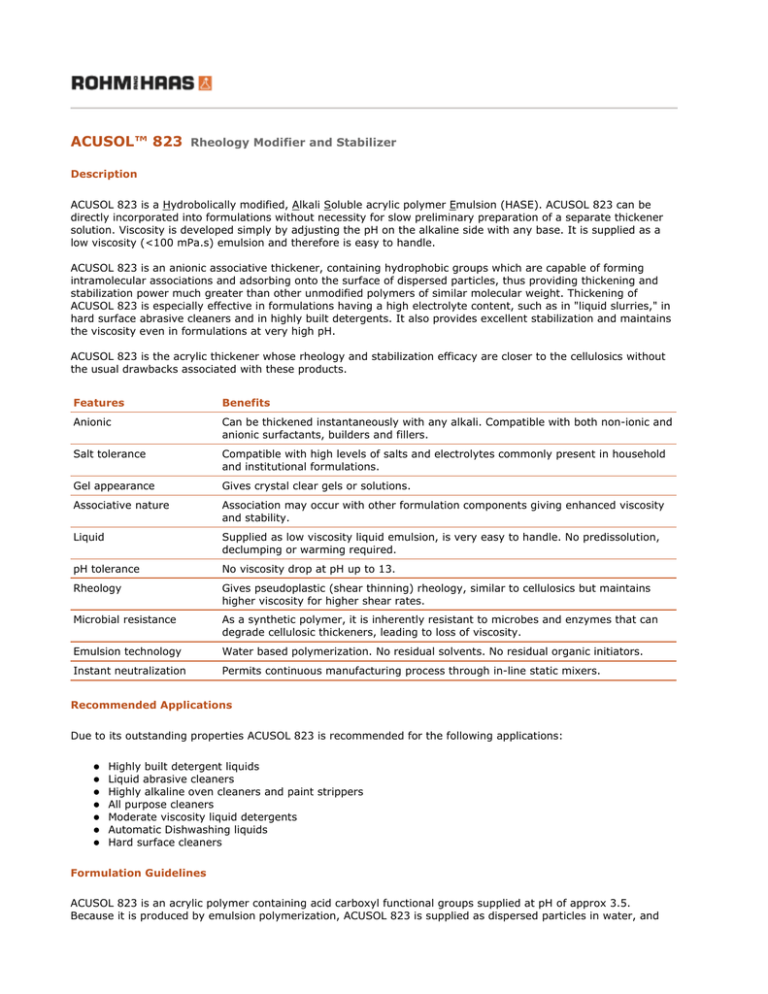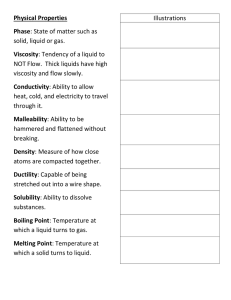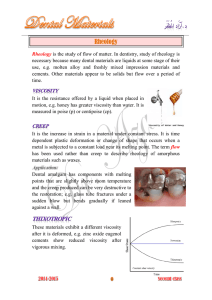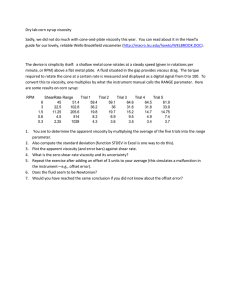
ACUSOL™ 823 Rheology Modifier and Stabilizer
Description
ACUSOL 823 is a Hydrobolically modified, Alkali Soluble acrylic polymer Emulsion (HASE). ACUSOL 823 can be
directly incorporated into formulations without necessity for slow preliminary preparation of a separate thickener
solution. Viscosity is developed simply by adjusting the pH on the alkaline side with any base. It is supplied as a
low viscosity (<100 mPa.s) emulsion and therefore is easy to handle.
ACUSOL 823 is an anionic associative thickener, containing hydrophobic groups which are capable of forming
intramolecular associations and adsorbing onto the surface of dispersed particles, thus providing thickening and
stabilization power much greater than other unmodified polymers of similar molecular weight. Thickening of
ACUSOL 823 is especially effective in formulations having a high electrolyte content, such as in "liquid slurries," in
hard surface abrasive cleaners and in highly built detergents. It also provides excellent stabilization and maintains
the viscosity even in formulations at very high pH.
ACUSOL 823 is the acrylic thickener whose rheology and stabilization efficacy are closer to the cellulosics without
the usual drawbacks associated with these products.
Features
Benefits
Anionic
Can be thickened instantaneously with any alkali. Compatible with both non-ionic and
anionic surfactants, builders and fillers.
Salt tolerance
Compatible with high levels of salts and electrolytes commonly present in household
and institutional formulations.
Gel appearance
Gives crystal clear gels or solutions.
Associative nature
Association may occur with other formulation components giving enhanced viscosity
and stability.
Liquid
Supplied as low viscosity liquid emulsion, is very easy to handle. No predissolution,
declumping or warming required.
pH tolerance
No viscosity drop at pH up to 13.
Rheology
Gives pseudoplastic (shear thinning) rheology, similar to cellulosics but maintains
higher viscosity for higher shear rates.
Microbial resistance
As a synthetic polymer, it is inherently resistant to microbes and enzymes that can
degrade cellulosic thickeners, leading to loss of viscosity.
Emulsion technology
Water based polymerization. No residual solvents. No residual organic initiators.
Instant neutralization
Permits continuous manufacturing process through in-line static mixers.
Recommended Applications
Due to its outstanding properties ACUSOL 823 is recommended for the following applications:
z
z
z
z
z
z
z
Highly built detergent liquids
Liquid abrasive cleaners
Highly alkaline oven cleaners and paint strippers
All purpose cleaners
Moderate viscosity liquid detergents
Automatic Dishwashing liquids
Hard surface cleaners
Formulation Guidelines
ACUSOL 823 is an acrylic polymer containing acid carboxyl functional groups supplied at pH of approx 3.5.
Because it is produced by emulsion polymerization, ACUSOL 823 is supplied as dispersed particles in water, and
therefore, it is easily handled due to its low viscosity. This emulsion is stable; however, membrane pumps with low
shear characteristics are recommended to transfer the emulsion during bulk handling: once diluted any type of
pump is suitable. ACUSOL 823 can be incorporated directly into formulations without concern about dissolving,
declumping or warming.
The preferred order of addition in detergent formulations using ACUSOL 823 is the following:
1.
2.
3.
4.
5.
6.
Introduce ACUSOL 823 diluted at least 3 times with formulation water
Introduce the non-ionic surfactants (if any) - the lower HLB first
Introduce the anionic surfactants (if any) - the lower pH first
Introduce builders, fillers, particulates
Introduce dyes, then perfume
Neutralize with the chosen alkali
NOTE
Although ACUSOL 823 will normally thicken solutions at pH above 6, its associative effect can be used to thicken
lower pH formulations. In this case apply the above mentioned procedure, neutralizing up to pH = 7.5, and wait
for complete association to occur, then adjust pH to the desired value preferably using a weak organic acid. A
minimum of 5% surfactant is necessary for this feature.
Performance Properties
High pH Tolerance
ACUSOL 823 maintains a flat viscosity/pH curve up to high pH levels.
High Salt Tolerance
ACUSOL 823 is more compatible than most of the other synthetic and natural thickeners with high electrolyte
levels.
ACUSOL 820 and ACUSOL 823 vs. Salt
ACUSOL 820
ACUSOL 823
Polymer, % active
1.5
1.5
pH
8.5
8.5
Electrolyte, % (NH4NO3)
0
2
0
2
immediate
66,000
39,000
22,000
14,000
after 12 hours
69,000
27,000
25,000
14,000
after 48 hours
71,000
19,000
27,000
13,000
Viscosity (mPa.s/cps, 12 rpm)
Pseudoplastic Behavior
ACUSOL 823 exhibits a pseudoplastic rheological profile similar to cellulosics but with higher viscosity at high
shear. ACUSOL 823 is less shear thinning than ACUSOL 820.
Microbial Resistance
ACUSOL 823 shows an excellent resistance to bacterial and enzymatic degradation. During a 4 month test even
with non-initially inoculated solutions, formulations thickened with ACUSOL 823 maintained essentially constant
viscosity while a non-resistant cellulosic grade became water thin and even the enzyme resisting grades lost more
than 2/3 of the initial viscosity.
Versatile Neutralization
ACUSOL 823 can be neutralized with any alkali: thickening occurs instantaneously, giving water clear solutions. It
has been observed that some very sophisticated formulations, thickened with acrylic or natural rheology modifiers
that were turbid, become crystal clear when using ACUSOL 823.
Typical Physical Properties
These properties are typical but do not constitute specifications.
Appearance
Off white milky liquid
Type
Alkali swellable associative thickener
Charge
Anionic
Solids, %
30
pH (as supplied)
3.2
Viscosity (as supplied)
about 30 mPa.s/cps
Density (25°C)
1.06
Equivalent weight*
191
*grams of dry polymer neutralized by 1 eq of NaOH
Storage/Handling
Keep from freezing. This emulsion product as supplied will irreversibly coagulate upon freezing.
Toxicology Profile
Overall Evaluation
ACUSOL 823 is considered non-toxic by single oral and dermal exposure. As supplied, ACUSOL 823 is slightly
irritating to the skin and moderately irritating to the eyes. However, tested as a 90% neutralized product
containing 1% active ingredient, ACUSOL 823 is considered non-irritating to the skin and only slightly irritating to
the eyes. ACUSOL 823 is considered as non-sensitizer. Testing in aquatic organisms has shown this product to be
non-toxic to Daphnia and fish.
Toxicity
Test/Species
Results
ACUSOL 823 (as supplied)
Acute oral LD50 - rat
> 5gr/kg - practically non-toxic
Acute dermal LD50 - rabbit
> 5gr/kg - practically non-toxic
Skin irritation - rabbit
slightly irritating
Eye irritation - rabbit
moderately irritating
ACUSOL 823 neutralized 90% with NaOH, tested at 1% a.i.
Toxicity, Acute
Oral LD50 - rat
> 5gr/kg - non-toxic
Dermal LD50 - rabbit
> 5gr/kg - non-toxic
Skin sensitization - guinea pigs
non-sensitizer
Skin irritation - rabbit
non-irritating
Eye irritation - rabbit
slightly irritating
Toxicity, Environmental
Daphnia magna EC50 - 48hr
> 1000 mg/l - non-toxic
Rainbow Trout LC50 - 96hr
> 1000 mg/l - non-toxic
Bluegill LC50 - 96hr
> 1000 mg/l - non-toxic
Material Safety Data Sheets
MSDS are available for all Rohm and Haas products. These sheets contain pertinent information that you may
need to protect your employees and customers against any known health or safety hazards associated with our
products.
We recommend that you obtain copies of the MSDS from your Rohm and Haas technical representative or from the
sales office nearest to you, before using our products in your facilities. We also suggest that you contact your
suppliers of other materials recommended for use with our products for appropriate health and safety precautions
before using them.
To obtain samples, technical assistance, a Material Safety Data Sheet (MSDS) or to have a technical
representative call for an appointment, contact the nearest Rohm and Haas branch office.
ACUSOL is a trademark of Rohm and Haas Company, or of its subsidiaries or affiliates. The company’s policy is to register its trademarks
where products designated thereby are marketed by the company, its subsidiaries or affiliates.
These suggestions and data are based on information we believe to be reliable. They are offered in good faith, but without guarantee, as
conditions and methods of use of our products are beyond our control. We recommend that the prospective user determine the suitability of
our materials and suggestions before adopting them on a commercial scale.
Suggestions for uses of our products or the inclusion of descriptive material from patents and the citation of specific patents in this publication
should not be understood as recommending the use of our products in violation of any patent or as permission or license to use any patents of
the Rohm and Haas Company.
©Rohm and Haas, 2008
All rights reserved.
January 2003
CS-757





